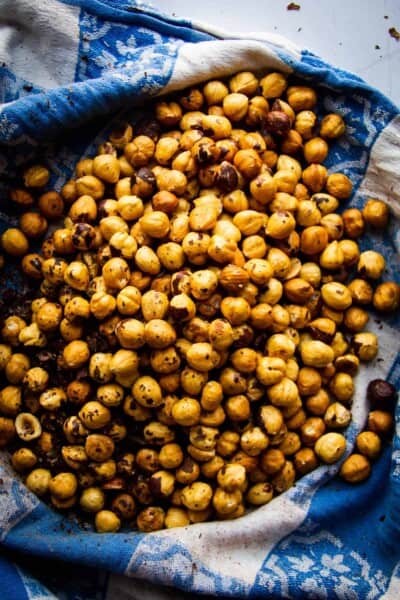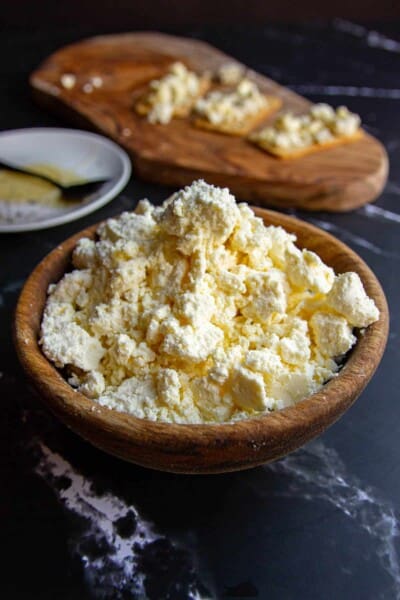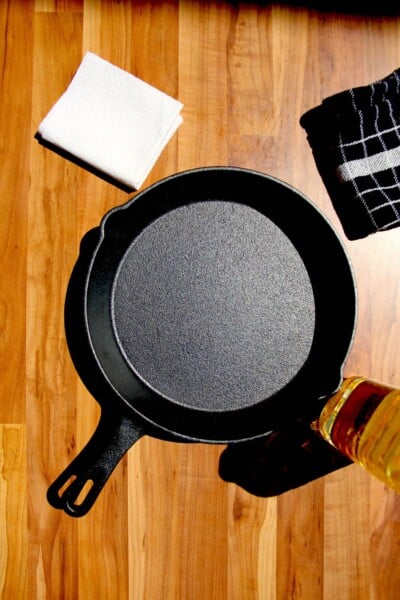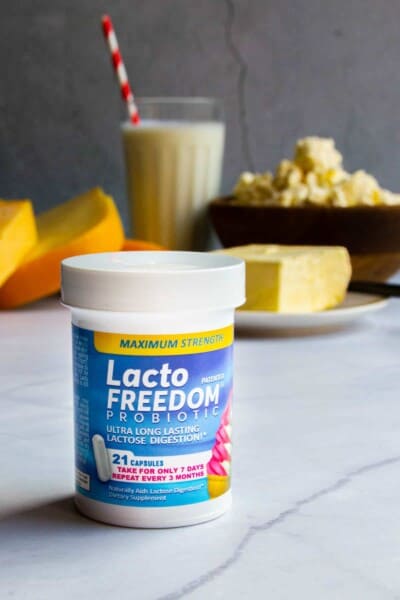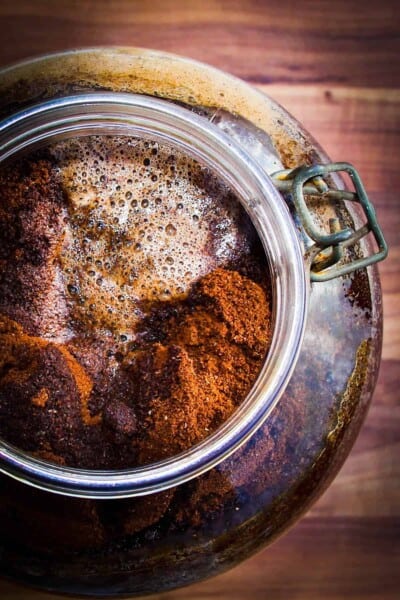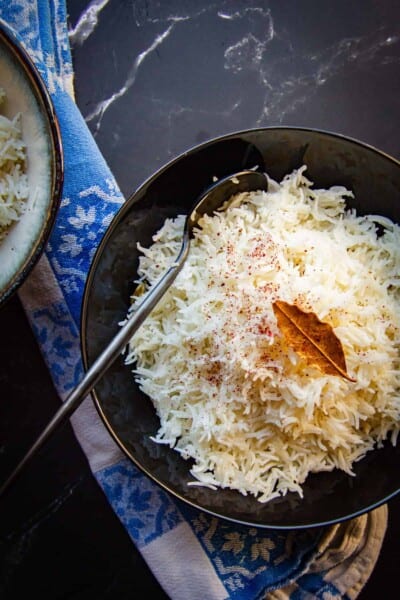Wondering how to thicken sauce the right way? Here are 6 of my favourite ways to thicken a sauce.
As a Chef, it’s paramount to know how to make sauce properly. There are tons of thickening options out there but I’m going to share with you the methods that have worked for me in professional kitchens.
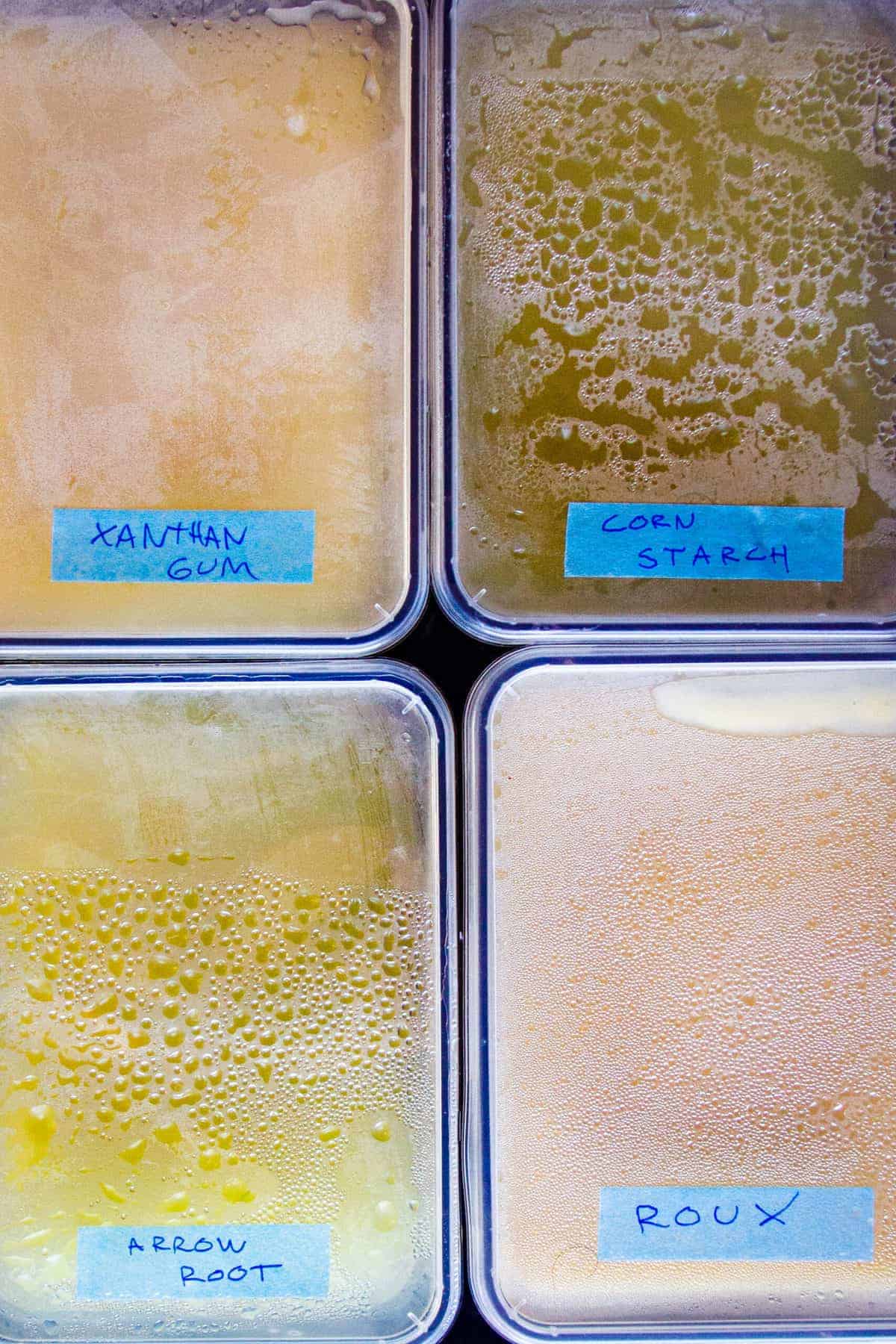
Here are My 6 Prefered Methods to Thicken a Sauce:
Below is a table of contents. You can click on the links to jump to each thickening method.
The ratios provided are guidelines and are not meant as the exact ratio for every recipe.
I tested all of the thickeners with a stock made from a bouillon cube (of course I’m not wasting real chicken stock on this test!).
**Always start with half the recommended amount. You can always add more later.**
- Here are My 6 Prefered Methods to Thicken a Sauce:
- How to Thicken Sauce
- #1. How to Thicken a Sauce With a Roux
- #2. How to Thicken a Sauce Using Corn Starch
- #3 How to Thicken a Sauce Using Arrowroot
- #3. How to Thicken a Sauce With Reduction
- #4. How to Thicken a Sauce Using Xanthan Gum
- #5. How to Thicken a Sauce Using Xanthan Gum + Gelatin + Fat
- #6 How to Thicken a Sauce Using Guar Gum
How to Thicken Sauce
These are all effective thickening methods for the right sauce. Be sure to choose the right thickening method for the right sauce.
It’s important to point out that whenever you add starch to a sauce you dilute the flavour slightly. Always add the least necessary to thicken the sauce to preserve as much flavour as possible.
#1. How to Thicken a Sauce With a Roux
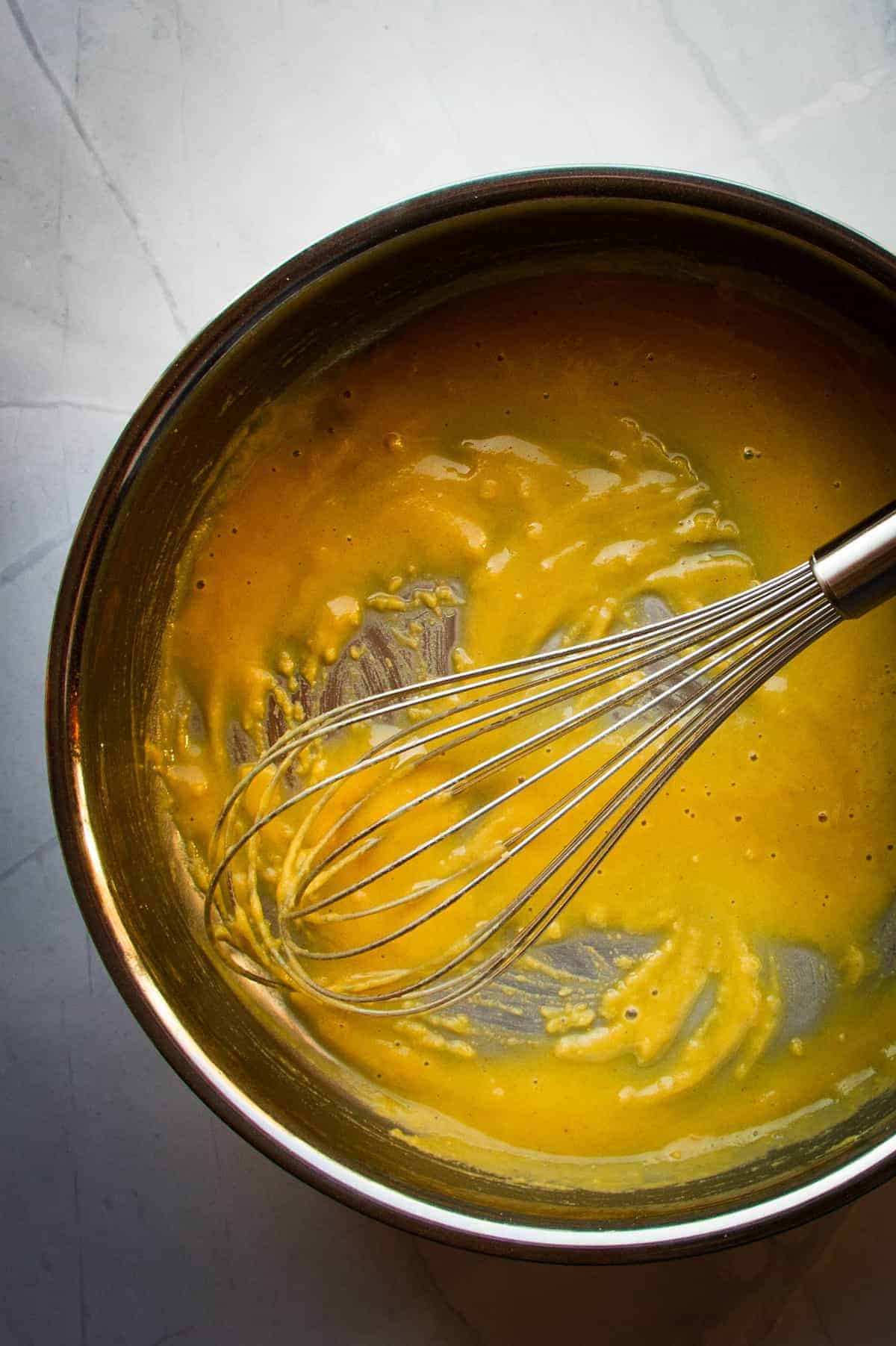
This is one of the oldest methods for thickening a sauce and the foundation for old-school sauces like bechamel, velouté and gravy.
A roux involves equal parts (by weight) of butter and flour. This is then cooked together for different periods of time to make a white, blond, brown, or dark roux. Light roux is used in light sauces and dark roux is used for darker sauces.
For example, if you’re making a cheese sauce, then you’ll want to go with a white or blond roux. If you’re making gravy, then the slightly more toasty flavours of a brown roux are more desirable.
Why It’s Useful
If you were to add raw flour into a sauce you would get clumps of flour with an undesirable raw flour taste. With a roux, the flour is cooked to remove this raw taste. The butter in the roux also prevents the flour from clumping, making a smooth, thickened sauce.
Cold Liquid or Hot Liquid to the Sauce?
In my training, I was taught to add hot liquids to a cooled roux and this has always worked for me. On the contrary, Chefsteps says the opposite – add cold liquid to a hot roux.
I couldn’t find sufficient evidence on what is actually better but I know that my method has always worked for me – cold (cooled) roux to hot stock. The reasoning behind this is to prevent lumps in the gravy.
Worst case scenario, you can always blend the sauce in a blender to make it smooth again.
Tips To Nail the Roux
- Using clarified butter will make the sauce more stable than using regular butter.
- Letting the roux cool slightly before adding liquid will prevent the liquid from boiling excessively and clumping.
- Add hot liquid to a cooled roux or cold liquid to a hot roux.
- Use a whisk to make the roux and mix in the stock.
Pros
- Flour and butter are widely available ingredients in most kitchens.
- Butter adds extra flavour to sauces.
- Works well with acidic foods.
- Doesn’t need to be blended with an electric tool.
Cons
- Contains dairy and gluten which are common allergens/intolerances.
- Must be made ahead of time and can’t be added last minute.
- Won’t add any sheen to the finished sauce.
- Makes sauces cloudy.
Chef Tip – If you’ve ever wondered why your cheese sauce is splitting and going stringy, it’s because of two reasons. Not using a roux, or not using enough fat. A roux will prevent this undesired texture in your sauce. Alternatively, you can use 35% cream to stabilize it.
Rough Ratio
For a thick gravy consistency try this:
Metric: 50g Flour + 50g Butter to 600ml stock.
US: 3 tbsp butter + 5½ tbsp flour to 2½ US cups stock or broth.

Method
Melt the butter in a pan. Add the flour and whisk until combined over medium heat. Cook at least 2 minutes to remove the raw flour taste of the roux. Cook to white, blond, brown or a dark roux depending on which sauce you are making.
Let the roux cool for 5 minutes and add your desired stock slowly, whisking vigorously to avoid lumps.
Preferred Recipe: Béchamel, cheese sauce, gravy.
#2.How to Thicken a Sauce Using Corn Starch
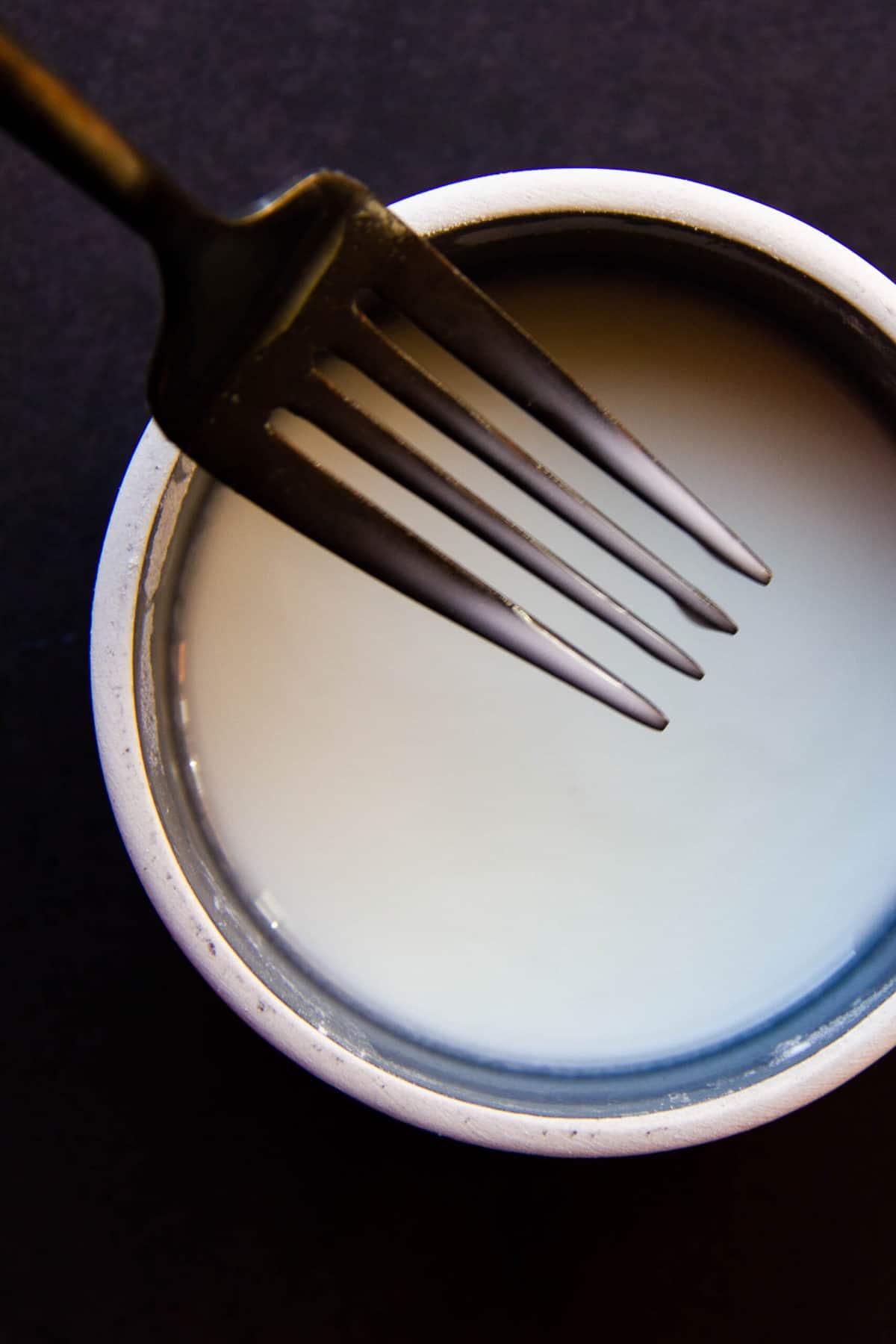
The most common example of a sauce thickened with cornstarch is in a jus lié, which is basically a thickened beef jus.
Cornstarch works similar to flour and it will clump up if not mixed properly. That’s why we use a slurry to dissolve the starch before adding this to the final sauce. A slurry is made by mixing the cornstarch in a separate bowl with cold water before adding this to the final product.
It must be boiled to be activated and adding it to cold liquids without cooking it will not work.
Why It’s Good
Cornstarch is effective because it can be added last minute and gives an appetizing shine to the finished sauce. It’s also flavour neutral, so it won’t add any extra flavour which can be good depending on the sauce.
Tips for Success with Cornstarch
- Mix a little water with the cornstarch in a bowl first to make a cornstarch slurry. This will prevent clumping. Add this pre-mixed slurry to your sauce.
- Always use cold water when making the slurry.
- Always bring the sauce to a boil after mixing in the slurry otherwise it will not work.
- You can use a whisk to mix in the cornstarch slurry.
- Doesn’t make the sauce cloudy like a roux.
Pros
- Provides an appetizing sheen to sauces.
- Doesn’t have to be prepared before making the sauce like a roux.
- Vegan, gluten, and dairy free.
- Twice the thickening power of flour.
Cons
- Not the longest lasting for prepared foods – water will weep out of the sauce after sitting in the fridge. You may need to add more when reheating.
- Some people are allergic to corn or do not wish to consume GMO foods which are pretty common in corn.
- Doesn’t work well with acidic foods.
- Doesn’t freeze well.
Ratio
For a medium consistency gravy:
US: 3 tbsp cornstarch + 3 tbsp of cold water to 2½ US Cups stock
Metric: 22g cornstarch + 50g cold water to 600ml stock
Method
Mix the cornstarch and water together to make a slurry using a whisk or fork.
Add this to your desired liquid, whisk and bring to a boil.
Preferred Recipe: Beef Jus, or gravy
#3How to Thicken a Sauce Using Arrowroot
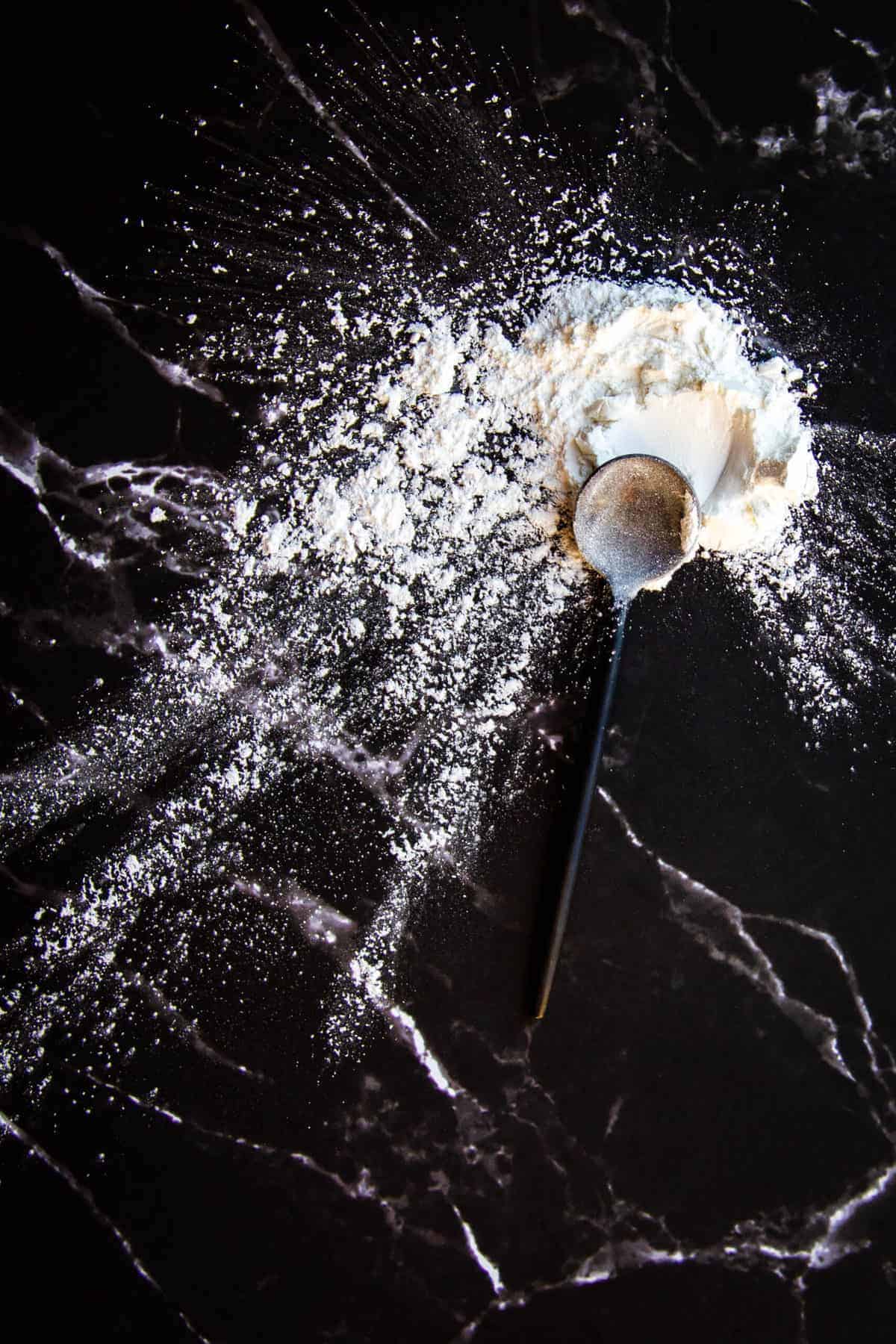
Arrowroot is a wonderful thickener produced from a tropical root that is native to Indonesia. It’s a great alternative to cornstarch and is used the same way.
Is Arrowroot Safe to Eat?
Arrowroot is not only safe to eat, but it’s also high in protein compared to other starches, and one of the easiest to digest. [1], [2]. Arrowroot was very popular in the Victorian era and has been tested thoroughly.
Although it’s not as powerful as Xanthan gum it may be a great alternative for people who suffer from digestive issues, are allergic to corn, are lactose intolerant or vegan. [2]
Arrowroot is surprisingly healthy and it may improve your immune system, may aid in weight loss, and is suitable for a vegan, dairy-free and gluten-free diet. [1]
Pros
- Gluten-free, vegan and corn-free.
- Neutral taste.
- Makes sauces very shiny and appetizing.
- Not weakened by acidic food like cornstarch.
- It’s nutritious and high in protein.
Cons
- Doesn’t work well with dairy sauces because it becomes slimy.
- Can’t handle excessive heat. Over boiling will cause it to break down and thin out.
- Might need to be added again if reheating a sauce.
How to Use Arrowroot
Use it just like you would cornstarch and make a slurry with 1 part arrowroot to 1 part cold water.
If you are having trouble mixing the slurry, add a little more cold water. Mix this into your sauce at the end, be sure it comes to a boil (or at least 80°C) then turn off the heat.
It’s always better to mix thickeners with the sauce using an immersion blender or stand blender but like cornstarch and roux, you can use a whisk to blend arrowroot into a sauce.
In my research, I found all sorts of different ratios and comparisons for cornstarch vs arrowroot but in my actual tests, they worked roughly the same. I actually used slightly more arrowroot than cornstarch to achieve what looked like a perfect consistency to me.
Rough Ratio
For a medium-thickened gravy try this:
Imperial: 4 tbsp arrowroot + 4 tbsp cold water to 2½ US Cups
Metric: 25g arrowroot + 60g cold water to 600ml stock
Method
Use arrowroot the same way you would use cornstarch. Mix the slurry together in a separate bowl and add to a hot liquid.
Arrowroot needs heat to be activated but it doesn’t like excessive heat so be sure to add the slurry at the end.
Preferred recipe: gravies, acidic sauces, non-dairy sauces.
#3.How to Thicken a Sauce With Reduction
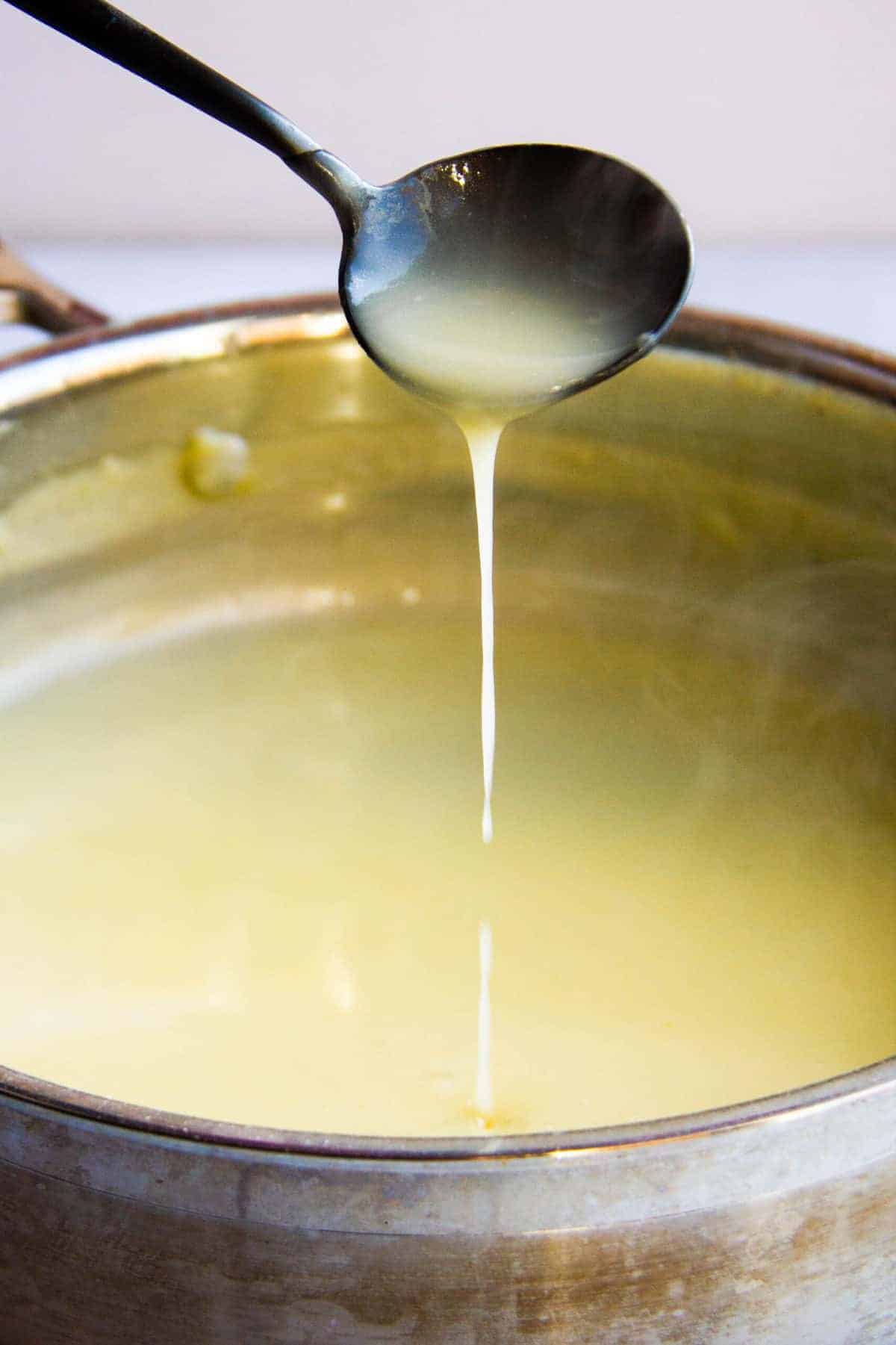
A reduction is a method in which a liquid is slowly cooked until excess water evaporates and thickens the sauce. This won’t work for every application and relies heavily on natural thickening properties in the sauce such as gelatin or pectin.
A good example of this is how tomato sauce thickens as it cooks. Or when jam gets really thick after cooking.
Why It’s Effective
Reduction is an attractive method for thickening because nothing is added to dilute the flavour of the sauce.
This technique works well for cream sauces, meat sauces, jams, fruit and vegetable purées or in a combination with other thickening methods.
The trade-off is it can be expensive to reduce a liquid to the desired consistency because not much is left after the water evaporates. It also won’t be an option for stocks that are already salted because the salt will intensify too much as the water evaporates.
Tips for Success with Reduction
- You may need to use a spatula to stir the bottom of the pan and avoid burning it.
- Be mindful of the amount of salt in the sauce because more evaporated water means an increase in saltiness.
Pros
- No added starch means the flavour won’t be diluted.
- Reducing a liquid concentrates the flavour in the sauce.
Cons:
- Takes a long time.
- Won’t work if the stock or sauce is already salty or sweet.
- Won’t work with every liquid as it must contain pectin or gelatin.
- Can be expensive because you’ll end up with less sauce after reducing it.
Rough Ratio
This can vary greatly depending on what you’re cooking. Normally a recipe will ask you to reduce a liquid by ½ or ⅔ of the starting volume.
Preferred Recipe: Beef Jus, cream sauces and tomato sauce.
#4.How to Thicken a Sauce Using Xanthan Gum
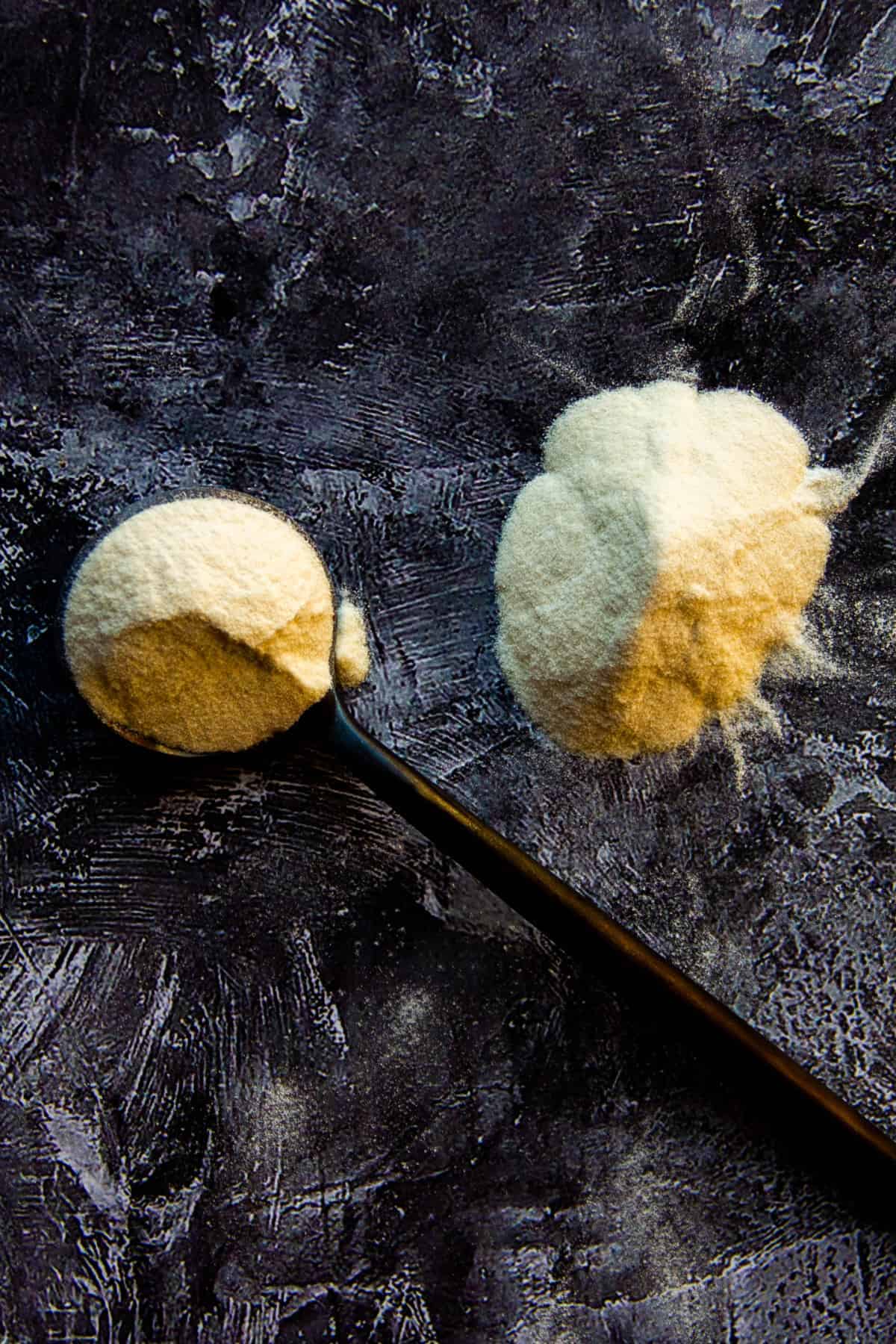
Despite the scary-sounding name, xanthan gum is one of my favourite thickeners and it’s actually been around since the 1960s. [1]
It’s a fermented product that’s not much different than vinegar or yeast.
Xanthan gum has been a popular thickening method for many fine-dining restaurants that was first introduced in the era of molecular cuisine in the 1990s.
Why It’s Effective
Xanthan gum is great if you know how to use it.
Xanthan gum gives the finished sauce a beautiful shine and also helps to hold ingredients together, even though it’s not technically an emulsifier. (for example salad dressings that never split!).
The problem is it’s super powerful and if you don’t know what you’re doing, you can completely destroy a sauce by adding too much (been there done that).
To prevent this, start with a very small amount and add more until you are happy with the consistency.
Because of its strength, very little is actually needed to work and the flavour of the sauce is not diluted as much as with a roux or cornstarch slurry.
It also doesn’t need to be heated like cornstarch and starts thickening instantly.
Where Does Xanthan Come From?
Xanthan gum is the by-product of bacteria that ferments on grains like corn or wheat.
Is it Safe?
Yes. It has been used since the 1960s and has been approved for use by the FDA with no limit to how much xanthan gum food can contain. [3]
The European Food Safety says “ No adverse effects were reported at the highest doses tested in chronic and carcinogenicity studies and there is no concern with respect to the genotoxicity.” [4]
Pros
- Suitable for keto, gluten-free, dairy-free and vegan diets.
- Requires very little to be effective.
- Gives sauces an attractive sheen.
- Does not need to be activated by heat to work.
- Shelf-stable for much longer than cornstarch or flour.
- Neutral taste.
- Helps to bind ingredients slightly, although not technically an emulsifier.
Cons
- Because it’s very powerful, too much can completely ruin foods.
- Knowing if it contains corn or soy can be difficult to find out. Corn and soy are popular allergens so Xanthan may not be suitable for everyone.
- Some people anecdotally report digestive issues with xanthan gum. Personally, I don’t have any problems with it but you may want to test it first. Although you’ve probably had it in fine-dining restaurants or prepared food without realizing it.
- Needs to be properly blended with an immersion blender or stand blender. Using a whisk will not work.
How to Use Xanthan Gum
Xanthan gum must be properly blended using an immersion blender or stand blender. Don’t use a whisk as you would with cornstarch because it will not mix as well and you could get an un-even sauce.
It’s even better if mixed with other dry ingredients first like sugar or blending in a small amount of oil as this helps to prevent clumping. Although I don’t find this necessary as long as you blend the whole liquid with an immersion or stand blender.
Ratio
For a salad dressing try this:
1/16th tsp of xanthan to about 1¾ US cup (400ml) finished dressing.

Let’s Talk Gravy
In my experience using Xanthan gum alone will not make a great gravy and you will need gelatin and fat to make a nice consistency.
When you add too much Xanthan gum the mouthfeel will be gummy and very unpleasant. It’s really easy to add too much Xanthan so be extra careful with this stuff.
Let it sit in the sauce for 2-3 minutes before adding more as it takes a few minutes to properly dissolve.
If you have a gelatin-heavy, pressure-cooked chicken stock like this one, then you can blend this with Xanthan and a bit of butter and you’ll have a beautiful sauce. If you have store-bought chicken stock or broth, see the next heading for a cool trick.
For a lightly thickened gravy:
3/8 tsp Xanthan gum + 1 tbsp (18g) butter blended into 2½ US cups (600ml) gelatin-rich stock or broth.
Preferred Recipe: Lemon vinaigrette, salad dressings, gravies, beef jus.
#5.How to Thicken a Sauce Using Xanthan Gum + Gelatin + Fat
When you combine xanthan gum with gelatin and fat, that’s where the magic happens.
The gelatin and xanthan gum work together to thicken the sauce and the fat adds flavour. The xanthan gum helps to keep the fat from separating in the sauce.
Why It’s Effective
This sauce is pretty fun because you can get a similar texture to a beef jus that took 3 days to make, in a matter of minutes.
Obviously, the flavour will not be the same as a real beef jus but the sauce is still very tasty and can be made in less than 5 minutes.
Ratio
For a Medium Consistency Sauce
- 600ml (2½ US cups) Chicken Broth
- 4 sheets of Dr. Oetker Gelatine .
- 3/8 tsp Xanthan Gum.
- 80g (5 tbsp) Butter, Beef fat, Bacon fat or Chicken fat.
- Salt, pepper, lemon juice to taste.
- Bloom the gelatin sheets in cold water for 1 minute.
- Remove the gelatin from the water and add this to the cold chicken stock.
- Bring the chicken stock to a boil, then turn off the heat.
- Add the xanthan gum and fat and blend with a hand blender in a large pot.
- Season.
The sauce is ready to go after blending. If you freeze the sauce or reheat it the next day it may lose its thickening power because gelatin doesn’t like too much heat or freezing. Simply bring back to a boil and add another gelatin sheet.
Recipe inspired by the Modernist Cusine at home. I removed the liquid lecithin and cut down a lot of the fat to make it lighter.
#6How to Thicken a Sauce Using Guar Gum
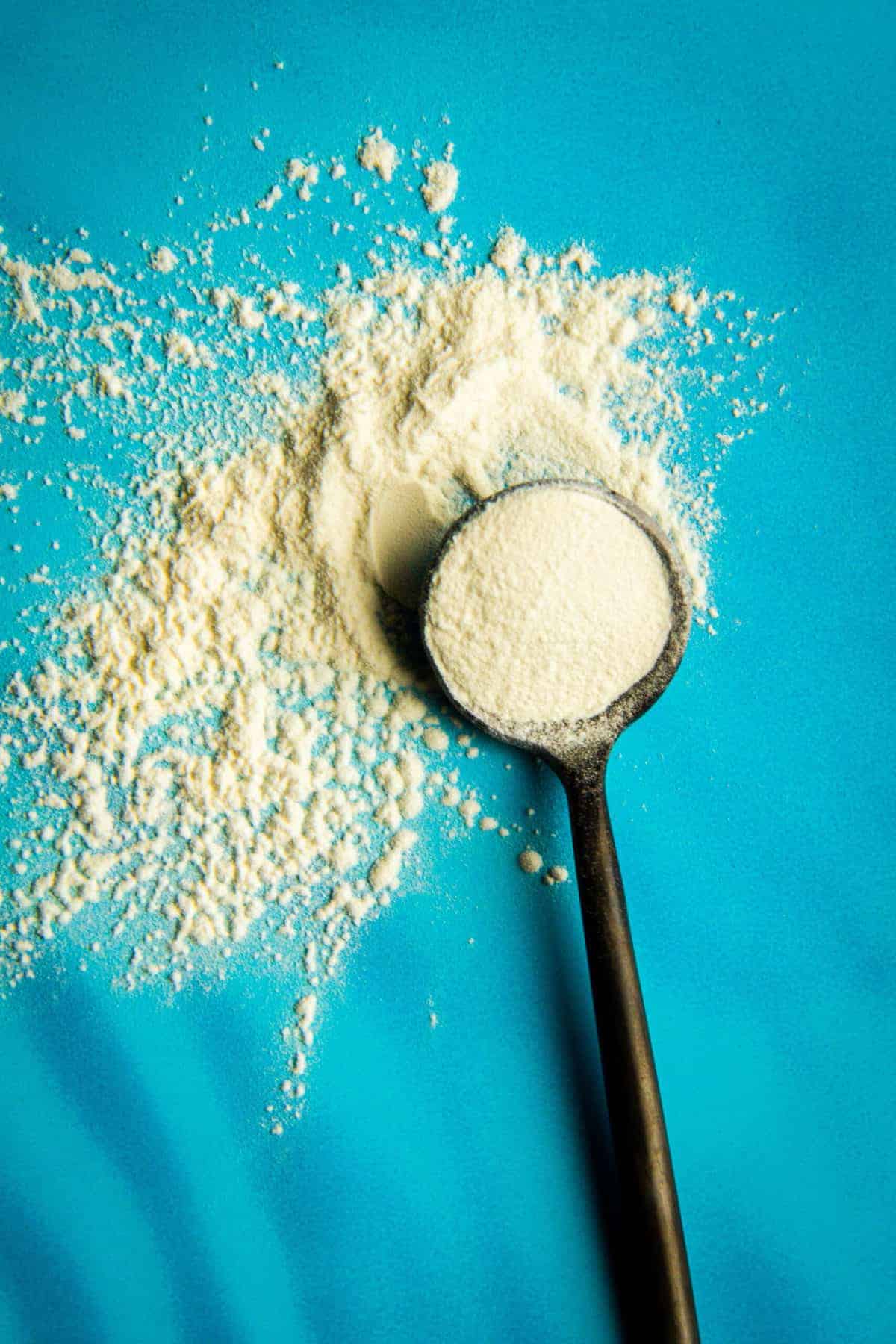
What is it?
Guar gum is a thickener harvested from Guar beans and has been used in processed foods since the 1950s.
Similar to Xanthan gum, Guar gum is another popular gluten-free alternative for baking products. It can also be used in sauces, soups and salad dressings.
Is it Safe?
In small amounts, Guar gum is not only safe but can also provide some health benefits.
Guar gum is taken medically for people with digestive issues such as Crohn’s disease and IBS. Because it’s high in soluble fibre, Guar gum can lower cholesterol and helps to maintain your blood sugar level. [3]
It was once banned by the FDA because a weight-loss company used extreme amounts (more than 15g) in their diet pills and this caused some internal blockage for some people.
Using that much Guar gum in foods would completely destroy whatever sauce you are making, so it’s nothing to be concerned about. Like Xanthan gum, it’s not toxic, just a very strong thickener. [4]
Why It’s Effective
Guar gum is almost as powerful as Xanthan gum and gives a great mouthfeel to sauces.
After testing, I was surprised to find that the texture of the sauce blended with Guar gum was much better than the Xanthan gum. Guar gum can be a great substitute for people who don’t want to use Xanthan gum.
It’s also used in ice cream products to slow the formation of ice crystals which means extra smooth ice cream and sorbets.
Although I did not try this, Guar gum and Xanthan gum are even more effective when mixed together.
Pros
- Gluten-free.
- Stronger than cornstarch and flour.
- Slows the formation of ice crystals, making ice cream smoother and better textured.
- Stabilizes emulsions just like xanthan gum.
- Works for hot and cold applications.
- Doesn’t require heat to be activated.
Cons
- Some people can be allergic to it although most people are fine.
- The cost has gone up because drilling companies also use it.
Ratio
Medium Thickened Gravy
1 tsp to 2½ US cups (600ml) liquid.
How to Use
Blend the sauce together with the Guar gum using a hand blender or stand mixer. Keep in mind it’s more powerful than Cornstarch but weaker than Xanthan gum.
Preferred recipe: lemon sorbet, fruit sauces, ice creams, gravies.
The Bottom Line
As you can see, there isn’t a one size fits all method for how to thicken a sauce. Each thickener is better suited to a different sauce.
It’s important you try for yourself what works best. Start experimenting with some of these techniques and see what you like the most. Remember the golden rule in cooking – you can always add more but you can never take away what you’ve put in. Start with small amounts and gradually increase until you’re happy with the end result.
I love using Xanthan gum for its neutral taste, longevity in sauces, and overall power means that it doesn’t take much to get results. But after testing all of the starches, Guar gum had a surprisingly nice texture that was better than Xanthan gum.
Use this guide to help you whenever you’re stuck or need a quick ratio reminder. If you liked this guide, bookmark it for later or share it with someone who needs help with thickening sauces.
Next up, let’s take a look at the best knife sets for home.
Happy Cooking!
Need some recipes to test out your new skills? Try these!





Contents
- Here are My 6 Prefered Methods to Thicken a Sauce:
- How to Thicken Sauce
- #1. How to Thicken a Sauce With a Roux
- #2. How to Thicken a Sauce Using Corn Starch
- #3 How to Thicken a Sauce Using Arrowroot
- #3. How to Thicken a Sauce With Reduction
- #4. How to Thicken a Sauce Using Xanthan Gum
- #5. How to Thicken a Sauce Using Xanthan Gum + Gelatin + Fat
- #6 How to Thicken a Sauce Using Guar Gum





